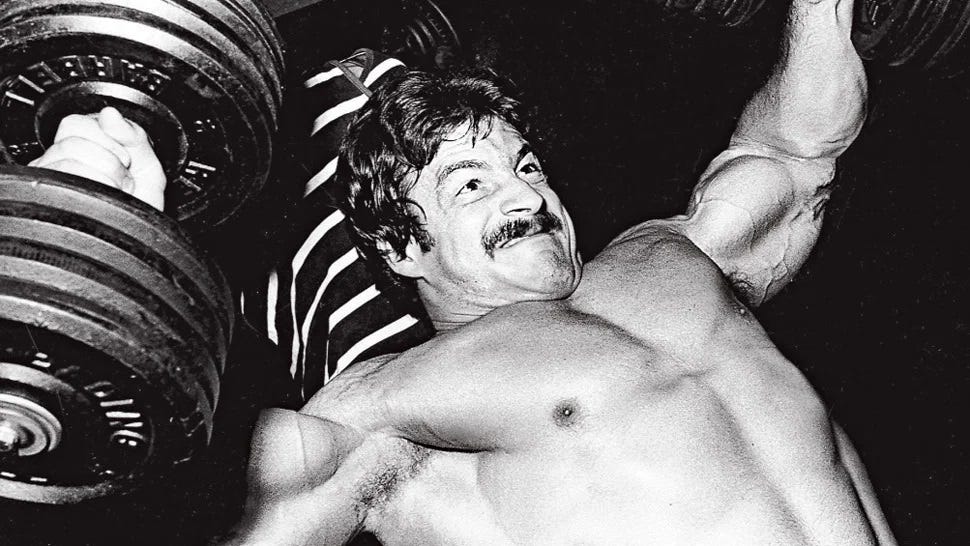Home | Articles | Book | Video | Training
Click Here to Sign Up for Your Free High Intensity Training Magazine Subscription
Mike Mentzer's Pre-Exhaustion Workout For Maximizing Muscle Growth
In the realm of bodybuilding and strength training, there are numerous training methods and techniques utilized to optimize muscle growth. One innovative approach, known as pre-exhaustion training, was popularized by the legendary bodybuilder Mike Mentzer. This training method involves isolating and fatiguing the target muscle group with an isolation exercise, followed by a compound movement that recruits multiple muscle groups. In this article, we will dive deeper into the world of pre-exhaustion training, exploring its definition, benefits, and example workout program.
What is Pre-Exhaustion?
Pre-exhaustion training, as the name suggests, involves pre-fatiguing a specific muscle group before proceeding to a compound exercise. It strategically targets the primary muscle group intended for growth and ensures its maximum involvement during compound movements. The technique typically involves performing an isolation exercise, which exclusively stresses the targeted muscle, followed by a compound exercise that recruits additional muscle groups.
Pre-Exhaustion Benefits
1. Enhanced Muscle Recruitment: By pre-fatiguing the primary muscle group with an isolation exercise, pre-exhaustion training forces the target muscle to work harder during the subsequent compound movement. This increased load stimulates greater muscle fiber recruitment, leading to improved muscle development and overall growth.
2. Overcoming Limitations: In certain compound exercises, smaller muscles or synergists may become the limiting factor, preventing the target muscle from being fully stimulated. Pre-exhaustion helps overcome this limitation by specifically fatiguing the target muscle, allowing it to be the primary driver during compound exercises. For instance, if the triceps are the primary focus, pre-exhaustion training ensures that they do the majority of the work during exercises like bench presses.
3. Muscle Imbalance Correction: Pre-exhaustion training can be particularly beneficial in addressing muscle imbalances, which often occur when certain muscle groups overpower others. By pre-fatiguing the dominant muscle group, the weaker muscles are given a chance to work uninterrupted during compound movements, leading to balanced muscle development and reducing the risk of injuries caused by muscle imbalances.
4. Plateau-Busting Potential: When progressing through a lifting routine, muscle adaptation and growth can sometimes reach a plateau. Pre-exhaustion training offers a new stimulus for the muscles by targeting them in a fatigued state, thereby challenging them to adapt and grow beyond their previous limits.
Pre-Exhaustion Training For Chest
To implement a pre-exhaustion training program effectively, it is crucial to select appropriate exercises and understand the relationship between the isolation exercise and the compound movement. Here's an example of a Mike Mentzer pre-exhaustion workout for building chest muscles:
1. Isolation Exercise: Dumbbell Flyes
- Warm up with light weights, performing 1-2 sets of 12-15 reps.
- Increase the weight to a challenging load for 1 all out set of 6 to 10 reps, focusing on squeezing the chest muscles throughout the movement.
- Maintain a controlled tempo and avoid using excessive momentum.2. Compound Exercise: Incline Barbell Bench Press
- Immediately transition to the compound movement.
- Perform 1 set to failure of 6 to 8 reps with a weight that challenges the chest muscles while maintaining proper form.
- Engage the chest muscles, pushing through the bar in a controlled manner.
Pre-Exhaustion Limitations and Considerations
While pre-exhaustion training offers significant benefits, it is essential to consider a few limitations and factors for a successful implementation:
1. Technique and Form: Maintaining proper technique and form is crucial for maximizing the effectiveness of pre-exhaustion training. Understand the correct execution of each exercise to ensure optimal muscle recruitment and to minimize the risk of injury.
2. Fatigue Management: Pre-exhaustion training can be demanding, both physically and mentally. Adequate rest and recovery between workouts are crucial to minimize the risk of overtraining and promote muscle growth.
3. Exercise Selection: Choose exercises that effectively isolate and stress the target muscles during the isolation phase. Additionally, consider compound exercises that recruit multiple muscle groups synergistically during the compound phase.
4. Individual Variability: Each individual's response to pre-exhaustion training may differ. Experimentation and personalization may be necessary to determine the optimal exercises, weights, and repetitions that suit your specific goals.
Conclusion
Incorporating Mike Mentzer's pre-exhaustion training method into your workout routine can revolutionize your muscle-building efforts. By intelligently structuring your workout to pre-fatigue the target muscle group, you can tap into its full potential during compound movements, leading to enhanced recruitment, balanced development, and continued progress. Remember, technique, exercise selection, and proper fatigue management are key components for a successful pre-exhaustion training program. With dedication, consistency, and the right approach, you will uncover new levels of strength and muscle growth.
If you have any questions about Mike Mentzer, Heavy Duty, High Intensity Training, Diet, etc. email us and we'll get back to you with an answer as soon as we can.
Click Here to Sign Up for Your Free High Intensity Training Magazine Subscription
Home | Articles | Book | Video | Training

Mike Mentzer Mr. America and Mr. Universe
